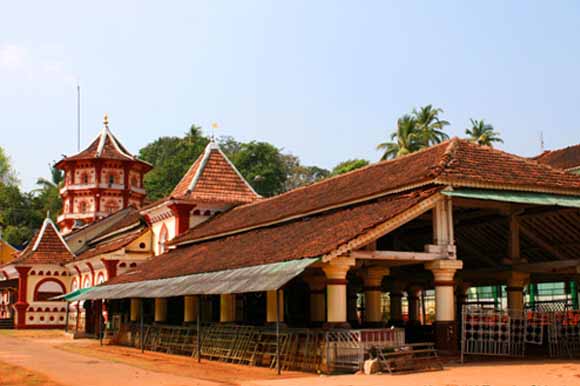Shri Kamakshi Temple

Information of Shri Kamakshi Temple, Shiroda, Goa
The Shri Kamakshi Temple is located in Shiroda in the southern Goan territory of India. The temple is located among lush green hills surrounded by natural beauty. This temple is dedicated to the Hindu Goddess Kamakshi who is another form of Goddess Parvati and is considered as the Divine Mother. She is the Divine consort of Lord Shiva who is the Supreme Being.
Shri Kamakshi Temple Religious Significance
The temple of Shri Kamakshi in Shiroda is a strict orthodox Hindu temple and follows a set of codes of conducts and dressing style. It prohibits the entry of foreign citizens whatsoever.
On Chaturdashi or pre-New Moon Day a procession of Shri Rayeshwar is carried out in the temple complex. During Amavasya or the new moon day a procession of idol of Shri Kamakshi and Shree Laxmi Narayan is taken around the temple in the presence of thousands of devotees. An important festival celebrated every year is Dusshera or Navaratri. During Dusshera, Divja or clay lamp procession is carried out where a large number of married women go around the temple complex with clay lamps.
This temple offers live Darshan on its website for devotees from all around. It also provides accommodation for pilgrims and devotees who come to receive blessings from Goddess Kamakshi.
Shri Kamakshi Temple Mythology & History
According to an old legend from the Kamakshi Mahatmyam in the Sahyadri Khand of the Skandha Purana it is said that, a respected Brahmin Agnimukh from Rai village had sent his son, Gunakar to the forest to collect ingredients for his holy rituals. Gunakar was swallowed by a demon Mahishasura during his trip. Worried about his son, Agnimukh went for help to Hari and Hara who suggested him to seek help from Goddess Kamakshi. After his request the Goddess appeared to help Agnimukh and challenged the demon in the form of Mahishasuramardini and defeated him after which he returned the Brahmin boy and went to live in the netherworld. Agnimukh was overjoyed and requested Goddess Kamakshi to reside in Rai Village to which she agreed.
This temple of Kamakshi in Shiroda was built around 16th century. This temple was originally sited at Rai in Salcette and was shifted to the present location due to numerous Portuguese invasions. The Portuguese army continuously destroyed Hindu temples and built churches in its place. The present structure of the Kamakshi was built during 1564 to 1568 AD because the faith of people in Hindu religion was firm.
Shri Kamakshi Temple Architectural Significance
The Shri Kamakshi Temple along with other Hindu temples in Goa has unique and a different rigid styled architecture with a blend of Muslim, Mughal and Portuguese art.
The temple is built facing the eastern side and has a gate leading to the massive temple complex known as Mahadwar. The main shrine comprises of a two stories Shikhara or an octagonal tower and can be reached by a series of stairs. A Kalash or a Golden vase is kept on the Shikhara. The sanctum sanctorum comprises of Sri Kamakshi Devi's idol standing in its most splendid form. The temple has a huge assembly hall which is a typical feature of any Hindu temple in India. A noteworthy feature seen in all Goan temples is the Deepastamba or lamp towers and is not an exception in this temple as well. An open lawn is present which is utilised for special rituals along with a tank of holy water. The water from the tank is considered sacred and can remove sin and illness from people who have strong belief.
- Andhra Pradesh Temples
- Assam Temples
- Bihar Temples
- New Delhi Temples
- Goa Temples
- Gujarat Temples
- Jammu and Kashmir Temples
- Karnataka Temples
- Kerala Temples
- Madhya Pradesh Temples
- Maharashtra Temples
- Odisha Temples
- Punjab Temples
- Rajasthan Temples
- Sikkim Temples
- Tamil Nadu Temples
- Telangana Temples
- Uttar Pradesh Temples
- Uttarakhand Temples
- West Bengal Temples